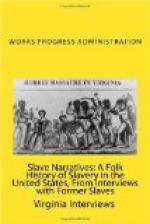“The slaves usually lived in a two-room house made of native lumber. The houses were all small. A four or five room house was considered a mansion. We made our own clothes, had spinning wheels and raised and combed our own cotton, clipped the wool from our sheep’s backs, combed and spun it into cotton and wool clothes. We never knew what boughten clothes were. I learned to make shoes when I was just a boy and I made the shoes for the whole family. I used to chop wood and make rails and do all kinds of farm work.”
“I had a good master, most of the masters were good to their slaves. When a slave got too old to work they would give him a small cabin on the plantation and have the other slaves to wait on him. They would furnish him with victuals, and clothes until he died.”
“Slaves were never allowed to talk to white people other than their masters or someone their master knew, as they were afraid the white man might have the slave run away. The masters aimed to keep their slaves in ignorance and the ignorant slaves were all in favor of the Rebel army, only the more intelligent were in favor of the Union army.”
“When the war started, my master sent me to work for the Confederate army. I worked most of the time for three years off and on, hauling canons, driving mules, hauling ammunition, and provisions. The Union army pressed in on us and the Rebel army moved back. I was sent home. When the Union army came close enough I ran away from home and joined the Union army. There I drove six-mule team and worked at wagon work, driving ammunition and all kinds of provisions until the war ended. Then I returned home to my old master, who had stayed there with my mother. My master owned about four hundred acres of good land, and had had ten slaves. Most of the slaves stayed at home. My master hired me to work for him. He gave my mother forty acres of land with a cabin on it and sold me a forty acres, for twenty dollars, when I could pay him. This was timbered land and had lots of good trees for lumber, especially walnut. One tree on this ground was worth one hundred dollars, if I could only get it cut and marketed, I could pay for my land. My master’s wife had been dead for several years and they had no children. The nearest relative being a nephew. They wanted my master’s land and was afraid he would give it all away to us slaves, so they killed him, and would have killed us if we had stayed at home. I took my mother and ran into the adjoining, Claire County. We settled there and stayed for sometime, but I wanted to see Kansas, the State I had heard so much about.”




